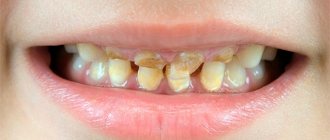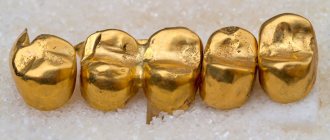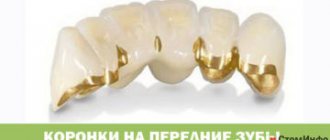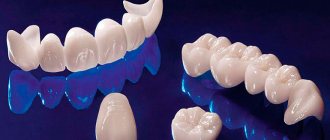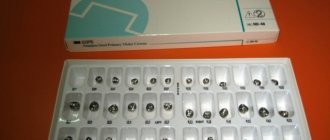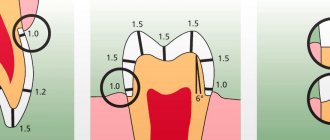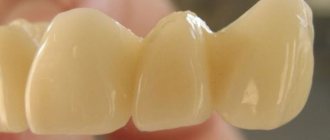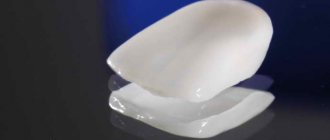3731
Artificial dental prosthetics allows a person to regain not only an attractive smile, but also restore the functionality of the jaw line.
One of the most popular materials from which the coronal part of a “new” organ is made is ceramics.
The component has proven itself to be excellent both in terms of technical and aesthetic characteristics. Unfortunately, the composition is not without its drawbacks, one of which is frequent chipping of the structure.
Causes of defects
Protective crowns can break:
- with bruxism (the habit of strongly clenching the jaws and grinding teeth);
- if during the creation of the prosthesis the master did not take into account the difference in thermal expansion of the materials that make up the structure;
- when the prosthesis has an irregular shape and is constantly subject to intense functional load of the opposite jaw;
- if plaque “lies” in a thick layer between the crown and the natural unit;
- in case of violation of the firing technology;
- repair of metal-ceramic crowns is inevitable when the patient himself is careless about the dentures, does not properly care for them (“injures” the structures with solid food, opens bottles with his teeth).
Destruction of “your” dental crown by more than half is a direct indication for prosthetics
Material for construction
A crack in a metal-ceramic product most often occurs if the metal-ceramic crown is made from a combination of raw materials. There are such chipping options:
- If the device consists of a metal frame and plastic lining, cracks and breakages are a common occurrence. This is due to the fact that plastic does not bond well with other materials. In this case, the structure should only be temporary;
- If the device consists of ceramics and metal, chips are not observed as often, since ceramics can only break under excessively high load or mechanical damage.
Description of material
A metal-ceramic crown is a structure whose base is a metal alloy, and the frame is a porcelain mass.
In the manufacture of the frame, a combination of noble metals, cobalt, nickel, and chromium can be used. It gives the device the necessary margin of safety and allows the tooth to fully fulfill its functional purpose.
Cladding the frame with a ceramic layer provides excellent aesthetics. And although in general such prostheses belong to the class of one of the most reliable and durable, they are more often than others susceptible to minor damage and chips, which, if ignored, are fraught with complete destruction of the artificial organ.
The risk group includes those owners of metal-ceramic crowns who, despite medical recommendations, abuse solid products, as a result of which the integrity of the product is compromised, and first microcracks and then chips appear.
What is a metal-ceramic crown?
Today, the choice of materials for making dental crowns is very wide: ceramics, zirconium dioxide, and plastic, but metal-ceramics continues to be the most popular and affordable. At the moment, metal ceramics are a kind of gold standard in dentistry, since similar designs have been used by doctors for many years and have proven themselves to be good.
Metal-ceramic crowns are a “cap” with machined fissures, which is placed on a ground tooth and completely imitates its shape, including all anatomical formations. The basis for the structure is a metal frame, which is covered on top with a layer of ceramics, indistinguishable in color from natural enamel.
The prosthesis is secured to the ground dental tissues using special composite or glass ionomer cement. In case of severe destruction, a metal tab is first installed, which serves as a reliable basis for the crown. Metal-ceramics are also used for the manufacture of bridges and clasp dentures supported both on the patient’s own teeth and on dental implants. In the latter case, the use of implants with metal abutments is recommended.
Modern technologies
Prosthetics is a modern dental technique for restoring “damaged” dental units. It happens that even on the highest quality metal-ceramic crown a chip appears - in this case the product must be restored. Restoring crowns is not an easy, painstaking job that requires a specialist to be highly qualified, precise, and careful. Restoration of metal-ceramic crowns, by the way, is practiced least often in modern dentistry (the prosthesis is replaced with a new one).
If the doctor decides to restore the “damaged” structure, then all manipulations are carried out only after removing the crown from the tooth. Is it possible to restore ceramic, zirconium, and plastic products: such work is carried out by a dentist (the doctor carries out the procedure without removing the prosthesis from the dental unit). Restoring the crown part of the tooth in this situation involves:
- surface polishing. The tooth remains intact, its aesthetics improves, and its shape changes slightly. Such work is carried out on units located in the smile zone if they have a slight chip;
- repair of a metal-ceramic crown can also be carried out using composite materials. The destroyed part of the prosthesis is filled with filling material, restoring its original size and shape. This method, however, is most often used for the restoration of plastic prostheses, but with a highly qualified doctor and when working with other structures it gives a good aesthetic result.
Modern materials
Today, there are several different materials from which dentures are made. Let's consider chipping options based on the use of different raw materials:
The photo shows the types of crowns
- metal-plastic: if the crown composition includes a metal base and a plastic outer covering, the likelihood of chipping is very high. This is explained primarily by the fact that the plastic simply does not connect well to the base. For this reason, these data are most often used as temporary prosthetic options, as well as during implantation, when the installed implants cannot be loaded too much,
- metal ceramics: if the crown consists of a metal base, but the outer coating is ceramic, the likelihood of chipping is reduced because the product is heat treated. However, under heavy load, the outer ceramic can still break off,
- solid ceramics: such crowns can also break. Despite the fact that a single piece of material is used, ceramics as a whole are not very durable, so a small piece may break off under load,
- dioxides: if the crown is made of zirconium or aluminum dioxide, then the likelihood of chipping is very low, since this is the most durable material for creating artificial teeth. As a rule, solid material is used (less often covered with a layer of ceramics) - it is even impossible to process it manually; special equipment is used. Therefore, the risk of breaking such a prosthesis is almost minimal.
Causes of damage
Damage to a ceramic crown can occur for the following reasons:
- the patient suffers from bruxism, and the dentist who performed the prosthetics was not informed about this diagnosis;
- a dental bridge includes a fairly large number of replaced dental units, as a result of which a fairly strong external and internal pressing force acts on it;
- during the manufacturing process of the device, the technician did not take into account the ability of the composition to thermal expansion;
- the shape of the prosthesis is made with errors, due to which uneven mechanical pressure is exerted on it, coming from the opposite area of the prosthesis, the jaw row;
- a foreign body has penetrated into the space between the surface part of the organ and the tooth, and a stony plaque has formed;
- violation of technology during the manufacturing process at the stage of firing the structure;
- non-compliance by the patient with the rules for using the product;
- incorrect preparation of the problem tooth, incomplete taper - as a result, tension arises inside the system, which provokes surface chips;
- too thick fixing cement composition;
- failure to comply with the technology and temperature conditions for working with ceramic composites specified by the manufacturer.
Restoring metal-ceramics: repairing a chip without removing the crown
Dental prosthetics not only gives a person back a beautiful smile, but also provides jawbone functionality. There are several types of restoration materials; metal ceramics are considered the best option. It has proven itself excellent both technically and aesthetically. Although it also has the possibility of chipping.
Main causes of damage
A ceramic crown can become damaged for various reasons. But, as dental technicians note, the most common cases of chipping are as follows:
- A man has bruxism, and the dentist who performed the prosthetics did not ask about the disease.
- The patient does not comply with the operating instructions.
- The product may chip due to a foreign body that has entered the space between the tooth and the crown.
- When manufacturing the device, the master did not take into account the composition’s ability to thermally expand.
- There are too many dental units in the bridge, so it bears a heavy load of both external and internal nature.
- The shape of the prosthesis is incorrect or poorly made, so the pressure on it from the opposite jaw row is uneven.
- The technology during firing of the structure was violated.
- The preparation was not performed correctly, the taper of the crown is incomplete, which causes severe stress within the system.
- During the restoration, an excessively thick fixing cement mixture was used.
During the operation of the crown, a chip appeared After the restoration procedure
Modern methods of restoration
A chip in the ceramic mass does not look very attractive. The patient’s quality of life decreases and various complexes appear. Modern dentistry offers several ways to restore teeth; there are even options in which you can sharpen a metal-ceramic crown without removing it.
The most common restoration method is polishing. The procedure is performed for minor damage to the ceramic part of the tooth. The main disadvantage of this method is that the crown loses its original shape, so it is most often used if the chip is in an inconspicuous place.
One of the main advantages of polishing is accessibility, since the cost of such procedures is low. During the event, the doctor treats the damaged area with a special polishing compound using a rubber brush, and the gaps between the teeth with finishing plates.
Repairing a chip on a metal-ceramic crown involves completely replacing it. This option is the most expensive of all, but also the most reliable.
If the structure was screwed in, then it is drilled out with a special drill and a suitable nozzle.
If the crown was fixed with dental glue, then preliminary decementing is required: a softener is applied, which will bring the glue to a paste-like state.
After the structure has been cemented, the dentist makes a control impression, prepares the tooth, if necessary, and then performs processing. Next, the model is sent to the laboratory for the manufacture of a new product. The effectiveness of this method cannot be compared with any other correction option in terms of efficiency and effectiveness.
The next restoration is carried out only after the crown is removed, but it should immediately be noted that this option has many disadvantages, so doctors do not recommend using it.
This is due to the fact that it is extremely difficult to maintain the integrity of a ceramic tooth if it is fixed with cement.
Although there are patients who agree to this procedure because of the low cost and short repair time.
There are more progressive and gentle methods for restoring a chipped tooth that do not destroy ceramics. Such dental procedures involve the use of directional ultrasonic vibrations, as well as the supply of compressed air. But such procedures are carried out only in good clinics that are equipped with expensive devices.
Repairs can also be made directly in the oral cavity. As a rule, such restoration leaves virtually no traces behind. Modern composites are of very high quality; after spraying, the metal does not show through.
A significant disadvantage of the procedure: no doctor can guarantee that the crown will last a long time and will not fall off immediately. Such manipulations are somewhat reminiscent of ordinary fillings.
Recovery after removal
Restoring a ceramic prosthesis is quite difficult, and only a professional can do such work efficiently. The fact is that when removed, the crown may be damaged or completely destroyed, and it will be impossible to restore the product in order to glue it back. To carry out such events you will need tools and special devices:
- a device equipped with a tip that resembles a crochet hook;
- separator bolt;
- pneumatic hand tools;
- mechanical devices for removing the prosthesis from the mouth;
- spitting utensils;
- forceps.
The manipulations are carried out under local anesthesia, so the patient should not experience pain. Immediately after removal, the denture is sent to a special laboratory, where a dental technician will carefully examine the structure and restore the product. The entire recovery procedure usually lasts no longer than 3-5 hours.
If a small chip has formed and the separated part is preserved, then it is simply glued to its original place using medical quick-drying glue. If the fragment is lost, then several ceramic layers are applied to the crown, thereby giving the tooth the required shape. After this, all that remains is to dry the prosthesis; this is done under the influence of high temperature in a special oven.
At the final stage, the technician grinds off excess fragments, grinds the crown and carries out final polishing.
But this method is used extremely rarely, since the percentage of prosthesis removal without damage is extremely low. In addition, there is a high probability of injury to the gums and soft mucosal tissues.
It is impossible to guarantee that such a design will last a long time, even if the work is done efficiently and professionally.
Oral repair
This option is most common among owners of metal-ceramic teeth. This is due to the fact that there is no need to remove the crowns; just open your mouth and the doctor will repair the damage on the spot. The procedure itself is performed in stages:
- Moisture is completely removed from the oral cavity. This is a prerequisite before any restorative procedures. The area where the chip formed is also thoroughly dried and then prepared with a diamond drill. This will make the tooth surface rougher, which will allow the composite to adhere to the ceramic more firmly and reliably.
- The surface is cleaned of any crumbs and diamond dust present on it. Next, the dentist impregnates the metal-ceramic crown and the area where there is damage with an acid mass for 1 minute. Modern clinics mainly use hydrofluoric acid for these purposes. After 60 seconds, the oral cavity is thoroughly rinsed under powerful water pressure and dried again.
- Then the doctor applies silane to the ceramic, which dries within a few seconds, and then treats the dental crown with a primer: this material enhances adhesion.
- After these steps are completed, the main work begins. Using a special composition, the required number of layers are applied to the chip site and the product is given the desired shape.
At the very end, the denture is treated with adhesive and then with a surface composite material. All that remains is to grind and polish the crown, and the procedure is considered complete.
Forecast of dental condition
It does not matter what technique was used to restore the metal-ceramic crown. It is impossible to predict exactly how long it will last. But you can determine the approximate service life based on several factors:
- Amount of damage. If the chip was large enough or there were several of them, then such dentures will collapse quite quickly, so it is best to initially replace the old structure with a new one.
- The basis. It is very important what the crown is made of: if it is metal, then the adhesion to the composite material will be several times lower than that of ceramic products.
- Malocclusion. This pathology can provoke a new breakdown almost immediately after restoration work.
- Non-compliance with operating rules and poor dental care.
- A bridge consists of a large number of dental units.
- A leaky connection causes the structure to quickly collapse.
As dentists note, the main cause of various damages is trauma and improper care of artificial teeth. If trouble does occur, restoration measures should be started immediately, otherwise the crown may completely collapse and a new product will be required.
Source: https://zub.clinic/koronki/skol-na-metallokeramike
Recovery stages
Gold crowns on teeth
- the chipped area is thoroughly dried;
- the area to be restored is treated with a bur (the roughness necessary for reliable fixation of the composite is achieved);
- Next, you need to clean, sharpen the surface layer and treat the structure with a special liquid solution;
- the defect of a ceramic or metal-ceramic crown is covered with special insulating gaskets;
- a composite of the desired shade is selected (the filling material is applied in layers, and as the work is completed it is polymerized with light lamps);
- The last stage of restoration of the crown of the front tooth is final grinding.
We invite you to familiarize yourself with Installing veneers in 4 stages
Restoration of the crown part of the tooth is also carried out using composite materials - photopolymer fillings, which are fixed to pins
Important: if it is not possible to repair the prosthesis “in place,” the dentist removes it from the tooth (drills it out or softens it using a special compound). Next, the doctor makes an impression and, based on it, a new prosthesis is made in the laboratory.
The surface of the prosthesis was cleaned with abrasive pastes on a low-speed tip.
About 1.5 mm along the surface of the ceramic layer along the periphery of the defect. (Fig.2)
An intraoral sandblasting device (Medi-Etcher, Bio-Art) was used to sandblast the surface of the metal frame and ceramic bevel. 50 micron aluminum oxide was used at a pressure of 2 bar until the surface was rendered matte (approximately 5-8 seconds). (Fig.3)
The surface was washed with water, dried and hydrofluoric acid 9.5% (Porcelaine etchant 9.5% Bisco) was applied to the ceramic for 2 minutes. (Fig.4)
Etching ceramics is a very important step. By sandblasting and etching ceramics with hydrofluoric acid, we create a micromechanically prepared retention surface. If 4% hydrofluoric acid is used, then it takes 4 minutes to etch the ceramic surface.
At this stage, the ceramic surface becomes very susceptible to contamination. It is necessary to strictly maintain the cleanliness of the ceramic surface from possible organic contamination (blood, saliva).
The most important point in the adhesive preparation of the ceramic surface. Without it there will be no success.
A ceramic primer is a chemical component with a bimolecular structure. At one end of the chemical chain we have a hydrophobic component (the composite monomer is connected to it); at the other pole we have a hydrophilic component (the ceramic component is connected to it).
I use a two-component primer Bis-Silan (porcelain primer Bis-Silan, Bisco). (Fig. 5) It is better to use a two-component primer. It is more chemically stable than one-component.
When using a one-component primer, carefully monitor the expiration date and store in the refrigerator when not in use.
The ceramic primer is mixed in a dose of 1:1 and applied to the surface of the ceramic (the primer will definitely get on the metal layer, don’t worry) and left for 30 seconds. and evaporates with a stream of air for 5-7 seconds.
In this case, I use One-step plus (Bisco) adhesive; the adhesive is left on the surface for literally 5 seconds. The solvent evaporates and the resin layer becomes thinner.
Stages of build-up
If the product breaks, it can be restored using the extension method. There is no need to worry, this procedure is painless and does not take much time - about half an hour. You can repair the damage in this way:
- First you need to thoroughly dry the product and fabrics. To do this, the specialist covers the intervention site with a rubber dam.
- Next, careful grinding is carried out using a diamond bur. It is important to create the rough surface needed to ensure adhesion.
- A bevel is formed on the device; to do this, you need to sharpen the product and remove excess microparticles.
- After the doctor has sharpened the surface of the device, it is cleaned with a special brush and treated with silane. After a few minutes, the surface of the product is completely dry.
- The chipped area is covered with an opaque substance, which hardens during the polymerization process.
- A composite material is applied layer by layer, which is pre-selected to match the enamel tone. Mandatory polymerization of each layer is carried out.
- The final stage is grinding the surface.
Read also: The canals were filled and the tooth hurts when pressed.
The extension procedure is not complicated, but it can only be done in a dentist’s office; it is impossible to repair an artificial structure in this way on your own.
Modern restoration methods
If the damage is small, the area needs to be treated to eliminate roughness. This is done with a diamond bur. Next, a slight bevel is created along the edge of the missing surface. The defect is closed with a special material covering the metal. Its polymerization will prevent noticeable translucency of the frame.
If it is noted that a lot of top material is missing, it is impossible to carry out repairs and restoration in case of such a nuisance as a volumetric chip of metal ceramics. A complete replacement of the model will be required. It's difficult to remove. This is a labor-intensive process that makes it difficult to carry out the process accurately. Difficulties often arise due to which it is damaged during the removal procedure. Therefore, if such conditions exist, they resort to creating a new analogue of the tooth, including bridge structures.
The sight of chipped ceramic mass causes aesthetic dissatisfaction, reduces the quality of life and instills doubts about one’s own attractiveness.
But in the vast majority of cases, repairing the structure is possible, and in fairly gentle ways.
Polishing
It is performed when there is a slight degree of damage to the ceramic part of the tooth. The disadvantage of the method is the partial loss of the organ's original correct shape, so it is used mainly where visual access is limited - on the lateral fragments of the jaw row.
The advantage is the low cost of the service. The essence of the procedure is to treat the damaged area with a special polishing mixture and a rubber brush, and in the gaps between the teeth - with finishing plates.
Complete replacement
The most expensive, but at the same time, reliable method. The main disadvantage is time costs. The prosthesis is dismantled by drilling with a bur with a special attachment if the structure was screwed in.
If the fastening method is cement fixation, the adhesive composition is impregnated with a softener and brought to the consistency of a paste. When the structure is removed, the doctor will make a control impression; if necessary, the tooth will be prepared and reprocessed.
The model is sent to a prosthetic laboratory, where a new product will be manufactured. In terms of efficiency and aesthetics, the result is incomparable to any other correction method.
A method that has more disadvantages than advantages. Its scope of application is extremely limited. The device is almost impossible to dismantle without maintaining its integrity if it is fixed to a cement composite.
The only advantage is that it is cheap and saves the patient’s time. There are more progressive ways to remove the structure that do not destroy the ceramics.
We suggest you read: The gum around the tooth is inflamed - what to do at home
Manipulations are carried out using directional ultrasonic vibrations and compressed air pressure. Both methods require expensive equipment, which not every clinic can afford.
Repair without removal
The manipulation is reminiscent of a filling. The advantage is that the place of the chip is absolutely invisible, and thanks to the quality of modern composites, the metal is absolutely not translucent. The disadvantage is that no specialist can give a guarantee of how long the crown will last.
How to restore a damaged crown?
Of all the types of restorative procedures found in dentistry, restoration of metal-ceramic crowns is the least common. The most reliable option is to replace the cermets. Naturally, it requires quite a lot of money, but the result is worth it. In some situations, restoration is possible, but it is performed outside the oral cavity. During this procedure, the crown is removed from the tooth, after which its integrity is restored.
Crown restoration “before” and “after”
Important! Since the crown is firmly connected to the tooth, in most cases it is impossible to remove it without damaging the prosthesis. Therefore, restorative work outside the oral cavity is practically not used and the crown often needs to be replaced.
If the crowns are made from other materials, such as ceramics, plastic or zirconium dioxide, then you will have to contact your dentist, who may try the following procedures:
- surface polishing. In this case, the tooth remains intact, maintaining aesthetics, but at the same time receives a slightly different shape. This option will be good in cases where the tooth is located outside the smile zone and the chip of the material is small (and did not lead to disruption of the functionality of the artificial tooth),
- the use of composite materials to restore teeth. During this procedure, the damage is built up to the level that the crown had originally. This is the most common option, which, with the right doctor’s approach, guarantees high quality recovery. As a rule, it is used when there are plastic crowns in the mouth.
On a note! Direct restoration, when the crown can be restored directly in the patient’s mouth, is mainly subject to plastic and metal-plastic prostheses. Their restoration is almost always possible, but the remaining crowns, especially with major damage, still have to be replaced in most situations.
How is recovery carried out?
- First of all, the chipped area is thoroughly dried,
- the area is treated with boron. It allows you to achieve the necessary roughness - so that the composite material holds better,
- cleaning the surface layer followed by treatment with a special liquid solution,
- then the doctor covers the defect with special insulating pads,
- At the last stage, the composite material of the desired shade is applied. Application is carried out in layers, which are polymerized by light lamps as they are applied. At the end of the work, final sanding is carried out.
If the crown needs to be replaced, it is removed from the tooth by drilling or softening the adhesive. Afterwards, impressions are taken (the tooth is reprocessed if necessary) and a new prosthesis is created in the laboratory.
The photo shows a crown that was removed from a tooth
The occurrence of a chip on the crown is not a reason to panic, because there are several ways to professionally solve this problem. In any case, you need to immediately contact a specialist who, after assessing the nature of the problem, will select the most appropriate method to eliminate it.
Crown repair using composite
Restoration of damaged units using filling materials and fiberglass pins is carried out only if the crown is slightly damaged. So, if a patient is missing more than half of “his” tooth, using this method is not rational. After the pulp has been removed, dentin loses most of its nutritional properties - adhesion (adhesion) of bone tissue to the composite will be minimal.
Before starting work, the doctor assesses the condition of the damaged tooth (the most informative method is radiography). In the presence of carious lesions and inflammatory processes, the dentist carries out appropriate treatment. Based on the x-ray image, the size (thickness, depth) of the pin is selected, the pulp is removed, it is cleaned, the dental canals are prepared for implantation, and they are washed with an antiseptic solution.
Next, a factory (individual) pin is placed in the canal, the remains are removed with a special dental instrument, and the remaining cavity is filled with cement. The next stage is restoration of the crown part of the tooth: the photopolymer composite is applied layer by layer and treated with an ultraviolet lamp.
So gradually the doctor manages to restore the original size (shape) of the damaged tooth. Advantages of the composite method: integrity of the structure, when working with a pin and filling there is no mechanical impact on neighboring units of the dentition, the procedure is painless, tooth enamel is not destroyed.
The main disadvantage of such a restoration is the risk of developing recurrent caries (the tooth itself darkens, but the filling remains unchanged).
Ceramic crown repair
It is rare that a dentist will undertake this type of work. The prosthesis is restored using composite extensions or polishing. Repair is only possible if the damage area does not reach a significant size.
The process of restoring dental crowns is a rather complex procedure. That is why dentists recommend monitoring your dentures in order to avoid such unpleasant consequences.
Our doctors
Brodsky Sergey Evgenievich
Deputy Chief Physician, Candidate of Medical Sciences, specialties: dentistry and medical microbiology
Work experience: since 1999
Salatsky Dmitry Nikolaevich
Chief physician, orthopedic dentist, gnathologist, maxillofacial prosthetist.
Work experience: since 1988.
Shirinyan Sarkis Kimovich
Dentist, implant surgeon, orthopedist, therapist
Work experience: since 2000.
Skranzhevskaya Svetlana Vladimirovna
Hygienist, dental assistant
Work experience: since 1994
Seredin Evgeniy Vasilievich
Implant surgeon
Work experience: since 2004
Malanova Olga Andreevna
Dentist, orthodontist, therapist
Work experience: since 2020
Rybakova Tatyana Evgenevna
Dentist-therapist-endodontist
Work experience: since 2006
Molodtsov Dmitry Evgenievich
Osteopathic dentist
Work experience: since 1998
Artemyeva Oksana Alexandrovna
Orthopedic dentist, therapist
Work experience: since 2001
Recovery technique after removal
Repairing a ceramic prosthesis is a complex manipulation that requires the doctor not only to have professional qualifications, but also to have good practice. After all, an unsuccessful attempt to remove the structure can completely destroy it.
The entire process is carried out using special tools and devices:
- a device with a tip that looks like a thin hook;
- forceps;
- separator bolt;
- pneumatic hand devices;
- mechanical prosthesis extractors.
The dentist carries out all his actions under local anesthesia, so the patient does not experience pain.
After the upper part of the structure is removed from the oral cavity, it is transferred to a special laboratory, where a dental technician will return it to its original appearance. The manipulation takes no more than three hours.
If the broken fragment was saved, it is simply glued into place with medical quick-drying glue.
If the fragment is not preserved, then the missing element is formed anew by applying multi-layer ceramics. When the desired shape is achieved, the workpiece is dried under high temperatures in special ovens.
The final stage is grinding off excess fragments, grinding and final polishing using the previously discussed method.
This method is not particularly popular, since the percentage of damage to the frame of an artificial tooth during its extraction is quite high.
It is associated with trauma to the gums and soft tissues of the mucosa. And the guarantee that the new model will last a long time is very doubtful.
Two ideal ways to eliminate chipped ceramics on a crown
19693
Owners of dentures sometimes face the problem of damage or chipping of the material from the surface of the crowns.
There are many reasons for chips, and many restoration methods.
Causes of damage
At the junction of the metal base and the ceramic lining, strong stresses sometimes occur, which can cause chips or other damage to the ceramic.
The main reasons for the formation of ceramic chips include:
- a large difference between the coefficients of thermal expansion of metal and ceramics;
- the intermediate part of the bridge structure is too long (bases made of noble metals have little rigidity, so with excessive chewing loads, chips on the surface may occur);
- malocclusion , sometimes in combination with pathological grinding of teeth;
- unprofessional tooth preparation (insufficient removal of hard tissues from the chewing surface);
- carrying out large-scale orthopedic work without the use of special equipment;
- the use of too thick cement to fix the metal-ceramic structure;
- entry of foreign bodies between the prepared tooth and the crown;
- poorly performed technical and laboratory work;
- injuries after a blow , fall, etc.;
- improper handling of artificial teeth by the patient (increased loads, temperature changes).
Restorative methods
It is important to know that a broken piece of ceramic should not be thrown away. It must be brought to the doctor, who will determine whether it can be replaced.
There are several ways to solve the problem, namely:
- Carrying out surface polishing. In this case, the shape of the tooth changes, but, nevertheless, its integrity and aesthetics are preserved. This method is one of the most economical. But it is unacceptable to use it if the teeth are located in the smile zone.
- Complete replacement of the structure. This is the most reliable method, but it requires a lot of financial costs. It also takes a lot of time to completely replace cermets.
- Restoration after removal. Since the crown is firmly fixed to the cement, it is very difficult to remove it. Professional skills and special tools are required to avoid damaging the product during removal.
- Repair without removal. This recovery method is the most popular. All manipulations are carried out directly in the patient’s mouth (the damaged piece is built up using composite materials). The downside of this type of repair is that the crown may not last very long.
If damage occurs as a result of trauma, restoration must be carried out as quickly as possible.
If there is a pronounced fracture line or a complete absence of ceramic coating, it is best to re-make the crown.
This type of damage usually occurs after poorly performed technical or laboratory work.
Restoration technique after removal
Repairing metal-ceramic structures is complex and requires strict adherence to technology. In order not to destroy the crown during removal, and to safely fix it in place after restoration, it is necessary to use special tools.
For example, the Coronaflex device allows you to remove the structure using compressed air. In this case, the crown is not damaged at all, but such a procedure requires large financial costs.
The method of de-cementing a structure using ultrasonic exposure also helps preserve the integrity of the product. But some materials are not susceptible to this effect (for example, glass ionomer cement).
The doctor can use special instruments with which he controls the force of the load on the tissue and the product:
- device with a hook-shaped tip;
- special forceps;
- separating bolt;
- pneumatic hand tools;
- crown removers manual or automatic.
As a rule, the structure is removed under local anesthesia, so the patient does not feel any discomfort.
After removal, the dentist gives the product to the dental technician in the laboratory. The restoration procedure for minor damage takes approximately 2-3 hours.
The specialist restores the original appearance of the product by gluing the missing piece using a special composition.
If a fragment is lost, a layer of ceramic is applied to the damaged area, after which the product is dried in a special oven, then sharpened and polished using special equipment.
This method is not very effective and there is a risk of damage to the crown during removal. In addition, it is possible that the structure will break again.
Repairing the product in the patient's mouth
The restoration procedure is similar to placing a filling. It is important that the crown is dry. Therefore, first of all, the area that needs to be restored is isolated from moisture using a rubber dam.
Next, the doctor performs the following manipulations:
- The damaged area is prepared using a diamond bur. This is necessary to create a rough surface and form a bevel, as a result of which the composite material adheres better.
- The entire surface is cleaned with a brush, after which it is treated with a special acid for a minute . For metal ceramics, only hydrofluoric acid is used. Then the crown is washed with a stream of water, followed by drying.
- The ceramic surface is treated with silane , which dries instantly, and then with a primer.
- Several layers of opaque material are applied to the damaged area , which covers the metal. Then polymerization is performed with a special lamp for a few seconds.
- Finally, the specialist covers the area with adhesive , after which he applies layer-by-layer composite materials (dentin, enamel) of the required shade. Each layer is polymerized with a halogen lamp.
- The last stage is grinding, polishing the surface and removing the rubber dam . After completing all the work, the doctor evaluates the aesthetic result of restoring the metal-ceramic crown.
Composite materials have excellent masking characteristics, therefore, as a result of restoring ceramics using this method, the metal is not visible at all. And thanks to polishing, the tooth acquires a natural appearance.
If the procedure is performed by an experienced specialist, then any traces of the work will be completely invisible. The disadvantage of the method is that doctors do not provide guarantees regarding the durability of the crown after restoration.
Forecast
A restored crown can last a year or several years, depending on certain factors:
- size of the fracture (if the chip is too large, the risk of repeated destruction of the crown increases);
- base material (composite materials adhere better to ceramics than to metal);
- incorrect bite (in some cases, this factor causes re-formation of a chip);
- improper or poor quality dental care can lead to damage to the restored crown;
- long bridge structure (due to increased micro bends, damage to the restoration is likely);
- violation of the tightness of the adhesion of ceramics and metal (ceramics may lose their strength over time).
It is important to correctly determine the cause of the chip. For example, if a breakdown occurred due to a violation of the crown manufacturing technology, then it needs to be completely redone. Only by finding out the cause can the recurrence of the defect be avoided.
Price
On average, the cost of restoring a chip on a metal-ceramic crown ranges from 2,500 to 4,500 rubles. Restoration using composite materials will cost approximately 3,000 rubles, and using solid inlays - from 4,000 rubles.
Re-polishing the restoration costs approximately 400 rubles, and making a new crown costs more than 10,000 rubles.
First of all, the price depends on the size and location of the damage. The qualifications of a specialist are of great importance. If the chip occurred as a result of an error by the dentist or dental technician, the patient does not pay for the repair.
The video presents a master class on intraoral repair of a prosthesis when the ceramic veneer is chipped.
Reviews
Most often, crowns are damaged after injury or due to improper dental care. Experts believe that it is necessary to restore chips as early as possible in order to avoid complete destruction of the product.
Source: https://www.vash-dentist.ru/protezirovanie/nesemnyie-p/koronki-np/skol-keramiki-kak-ustranit-defekt.html
Installation of the prosthesis
The main indication for the use of ceramics and metal-ceramics is a strong tooth root, but a large absence of a coronal part. Other clinical cases in which prosthetics are required: severe pigmentation of tooth enamel, progressive diseases of dentin of a non-carious nature, destruction of enamel under the influence of external or internal factors.
The preparatory stage is similar to the work of installing a composite; then the prosthetic tooth is ground down and a pin is placed in the canal. If the root is strong, but the tooth’s “own” crown is almost completely absent, a stump (inlay) is installed. This design strengthens the dental canals and allows the prosthesis to be securely fixed.
Damaged crowns made of metal-plastic and ceramics are restored “in situ”; metal-ceramic structures, as a rule, must be replaced
Pros and cons of metal-ceramic crowns
Among the advantages of metal-ceramic crowns is, first of all, their strength. Therefore, in most cases they are installed on chewing teeth. Undoubtedly, they look much better than purely metal crowns. In general, metal-ceramic crowns imitate real teeth well, but with the advent of new materials in prosthetics, preference in restoring anterior teeth began to be given to all-ceramic structures. When a combination of reliability and aesthetics is needed in the chewing area, then the best choice would be ceramic prostheses based on zirconium dioxide.
The advantages of the design include:
- Simple and safe prosthetic process;
- Use only hypoallergenic and fire-resistant materials;
- Effective restoration of chewing function;
- High aesthetic performance of crowns;
- Long service life;
- High strength;
- Resistance to chewing loads;
- Protecting the tooth from further damage;
- Artificial teeth are no different from natural teeth;
- Wide palette of colors to select the desired shade;
- Uniform distribution of chewing pressure;
- Strong fixation;
- Lack of special care;
- Affordable construction cost.
We suggest you read: Why do they put arsenic in the tooth?
The disadvantages of ceramic crowns include:
- Risk of chipping ceramics or breaking the structure;
- The need to prepare the tooth, which includes removal of nerves and significant grinding of the tooth;
- In the absence of tooth depulpation, complications arise in the form of pulpitis;
- Risk of allergies to metal frames or ceramics;
- Wear of opposing teeth;
- Showing through the metal frame from under the gums, especially in the area of the front teeth.
Oral repair
The process technology is carried out in stages and looks like this:
- The preparatory phase is the complete removal of moisture. This is a mandatory action before starting restoration work.
The area of the chip is thoroughly dried, after which the damaged area is prepared with a diamond stone bur.This is necessary so that the surface relief of the area where the chip occurred becomes a little rough - this way the composite will adhere more firmly to the main part of the ceramic crown.
- Next, the working area is cleaned of crumbs and diamond dust and impregnated with an acid mixture for 60 seconds. In dental practice, hydrofluoric acid is used for this treatment. After a minute, the tooth is thoroughly rinsed with powerful water pressure, after which the cavity is thoroughly dried again.
- The ceramics are coated with silane - it dries in a few seconds, then a thin layer of primer is applied to enhance adhesion.
- Using a special composition, the missing fragment is built up through multi-layer application.
The final phase is the application of adhesive and surface composite materials. The tooth is ground and polished.
We suggest you familiarize yourself with Red dots in the mouth on the cheek
The video presents an intraoral technique for restoring a chipped ceramic veneer on a tooth.
How to repair a metal-ceramic crown?
If you still have a chipped piece of ceramic, it is best to take it with you to your dentist appointment. It might be possible to attach it back.
In general, in addition to polishing the metal (if the chip occurred on a tooth that is far from visibility), the following repair options are also possible:
- Complete replacement of the metal-ceramic crown with a new one. This option is, of course, the most reliable, but also the most expensive;
- Removal of the prosthesis for repair. However, as a rule, the prosthesis is very securely fixed with cement, and during the process of removal and remounting the crown can be irreparably damaged;
- Repair of a crown in the mouth, without removal. This is what they resort to most often, although it does not provide the same high strength as it originally had.
Restoration of a metal-ceramic chip in the mouth occurs in one visit:
- First, the metal surface is processed and polished.
- Then the repaired area is dried and coated with a special binder that ensures tight adhesion to the ceramics.
- Afterwards, the composite material is applied to the chip, layer by layer, and illuminated with a UV lamp to harden.
- After hardening, the material is ground, it is given its original shape, and the restored crown no longer looks damaged.
Prevention and care
To avoid the need for restoration of primary (permanent) teeth, it is recommended to visit the dental office for a professional examination once every six months. In addition, it is recommended to evenly distribute the functional load on the jaw while eating (chew on both sides). Caring for “repaired” teeth should be even more thorough than for living teeth.
So, if a tooth with a filling (pin, inlay) has changed color, a chip or other flaws have appeared on it, this is a clear signal indicating the need to install a prosthesis (crown). So, it is not always possible to restore a damaged dental crown; in this case, it is better to remove the denture and replace it with a new one. In some cases, dentists prefer to use composite materials (fillings with pins) or core inlays (if the natural crown of the tooth is severely damaged) for tooth restoration.
The decision on whether to install metal-ceramic, ceramic, metal-plastic crowns or to “reanimate” teeth using photopolymer materials is made by the doctor after a comprehensive assessment of the condition of the oral cavity (and the affected unit itself) of a particular patient.
Repair of a metal-ceramic crown
Let’s say right away that in most cases, metal-ceramic repairs are not carried out. If the damage area is small, then there are several recovery options:
- Polishing and grinding of the crown. Of course, the tooth will change in size after this, but the cost of such a service will be several times less than installing a new prosthesis;
- Restoring a damaged area using composites. The dentist uses the material to give the tooth its original shape. But the service life is unlikely to increase.
Forecast
Regardless of which of the listed methods the restoration was carried out, it is very difficult to name a specific service life.
This is determined by the following factors:
- the magnitude of the damage - with sufficiently large chips, the risk that the new prosthesis will collapse quickly is much greater than with minor damage;
- the base of the product - if made of metal, the adhesion force with the composite is lower than with ceramics;
- bite pathology – a defect can provoke new damage immediately after repair;
- improper oral care;
- bridge system is too long;
- insufficient tightness of the adhesion during the restoration process - over time, it loses its ability to set even more, and the fragment will break off again.
The problem with the appearance of the analogue of the chewing element
The appearance of a small chip in the ceramic layer
What will the surface of the artificial tooth model installed for you look like if there is a chip on it on the metal-ceramic crown? There will be noticeable exposure of the base. This will become noticeable due to a decrease in the volume of the surface material and a different color of the metal base, which cannot be unseen.
Especially if there is a large chip in the cermet, what to do in this case will probably be important for every person. After all, the money has been paid, and the tooth seems to be in place. And the warranty on the model itself has a very short period (12 months). And I would like to know whether restoration of metal-ceramic crowns is even possible.
The problem of the appearance of the analogue of the chewing element will cause discomfort when smiling. If the metal-ceramic crown does break off, it will seem like a big hole.
Raw materials for crowns
Basically, the problem, when a piece of a metal-ceramic crown breaks off, is observed in cases where they are made from combined raw materials.
Chip options for different raw material compositions:
- If the composition includes a metal base and a plastic coating, then chips are quite common. This is explained by poor connection between the plastic and the base. It is advisable to use this restoration option as a temporary structure.
- If the composition includes ceramics with metal, chipping is less common, since ceramics break only under excessive load.
Chips on conventional metal-ceramic crowns are also possible if the patient prefers solid foods.
